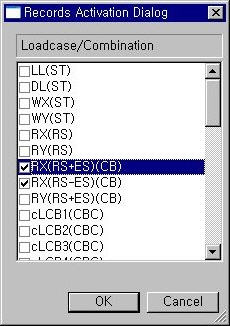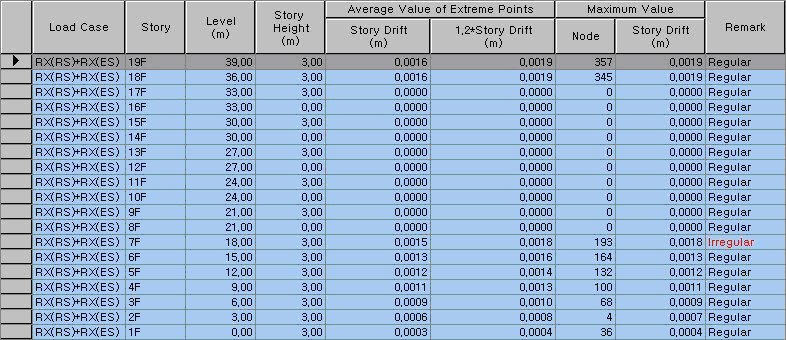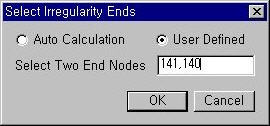Torsional Irregularity Check Table
Torsional Irregularity is checked for static and dynamic loads, and the status of irregularity is tabulated in a spread sheet format.
When "Story Shear Force Ratio>Consider Story Module"is checked in the "Model/Building/Control Data", accurate shear forces can be obtained for the story having the overlapping Module.
When Modules are defined in Results > Result Tables > Story > Define Module, the Module data is displayed in the first column of the table.
When the ratios exceed the allowable limit, they appear in red and 'Irregular' is printed in the Remark.
Table Tool in midas Gen offers a variety of powerful built-in functions. Refer to the following items for detail directions:
Usage of Table Tool
Terminology
Familiarize with Usage
Basic directions (Cell motion, selection, size control, etc.)
Data manipulation (Add, delete, modify data, etc.)
Copy/Paste data using clipboard
Supplementary Table functions
Table Sorting
Table format setting
Auto-fit column width
Graph printing
Supplementary functions by Table types
Node/Element Table
Results Table
From the Main Menu select Results > Result Tables > Story > Torsional Irregularity Check
Select Result Tables > Story > Torsional Irregularity Check in the Tables tab of the Tree Menu.
From Record Activation Dialog, select the load cases/combinations for which Torsional Irregularity will be checked.

Record Activation dialog box
Refer to Usage of Table Tool and check the following data:
![]() When Modules are not defined
When Modules are not defined

Load Case: Load case/Combination
Story: Story ID
Level: Story Elevation
Height: Story Height
1. Average Value of Extreme Points
Story Drift: Average of the combined story drifts of vertical members at corner (Extreme) points at a story for the given loading condition
1.2*Story Drift: Story Drift multiplied by 1.2
Note 1
From Context Menu, select "Select Irregularity Ends"
to select the ends.
Auto Calculation
Use auto-calculated Average Value of Extreme Points to evaluate the torsional irregularity at ends.
User Defined
Select User Defined and click the "Select Two End Nodes" Text Box. The view is then automatically converted to the Model View. Once the two end nodes are selected, 1.2 times the average story drift will be compared with the maximum story drift to evaluate torsional irregularity.

Select Irregularity Ends dialog box
2. Maximum Value
Node: Node numbers corresponding to the maximum combined story drifts at each story level for the given loading condition
Story Drift: Maximum combined story drift at each story level for the given loading condition
3. Remark
"Story Drift of Maximum Value" divided by "1.2*Story Drift of Average Value of Extreme Points" If it exceeds 1.0, "Irregular" is printed. If it is less than 1.0, 'Regular' is printed.
![]() When
Modules are defined
When
Modules are defined
The Module column is generated only when the Modules are defined. Torsional irregularity check results are generated as per the following Note.
Note
1. Irregularity check results for the top floors of each Module are not generated.
2. Story drifts used to evaluate torsional irregularity are calculated in the same manner as used in Results > Result Tables > Story > Story Drift.

Module: Module name is defined in Define Module
Load Case: Load case/Combination
Story: Story ID
Level: Story Elevation
Height: Story Height
1. Average Value of Extreme Points
Story Drift: Average of the combined story drifts of vertical members at corner (Extreme) points at a story for the given loading condition
1.2*Story Drift: Story Drift multiplied by 1.2
Note 1
From Context Menu, select "Select Irregularity Ends?to select the ends.
Auto Calculation
Use auto-calculated "Average Value of Extreme Points" to evaluate the torsional irregularity at ends.
User Defined
Select User Defined and click the "Select Two End Nodes" Text Box. The view is then automatically converted to the Model View. Once the two end nodes are selected, 1.2 times the average story drift will be compared with the maximum story drift to evaluate torsional irregularity.

Select Irregularity Ends dialog box
2. Maximum Value
Node: Node numbers corresponding to the maximum combined story drifts at each story level for the given loading condition
Story Drift: Maximum combined story drift at each story level for the given loading condition
3. Remark
"Story Drift of Maximum Value" divided by "1.2*Story Drift of Average Value of Extreme Points" If it exceeds 1.0, "Irregular" is printed. If it is less than 1.0, 'Regular' is printed.